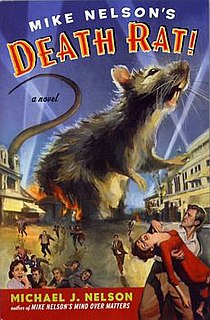An epistolary novel is a novel written as a series of documents. The usual form is letters, although diary entries, newspaper clippings and other documents are sometimes used. Recently, electronic "documents" such as recordings and radio, blogs, and e-mails have also come into use. The word epistolary is derived from Latin from the Greek word ἐπιστολή epistolē, meaning a letter.
The Saint is the name of a collection of serialized dramas featuring the fictional character Simon Templar, known as the Saint. He is featured in a series of books by Leslie Charteris published between 1928 and 1963. After that date, other authors collaborated with Charteris on books until 1983; two additional works produced without Charteris's participation were published in 1997. The character has also been portrayed in motion pictures, radio dramas, comic strips, comic books and three television series.

Leslie Charteris, was a British-Chinese author of adventure fiction, as well as a screenwriter. He was best known for his many books chronicling the adventures of the charming antihero Simon Templar, alias "The Saint."

Sir Arthur Thomas Quiller-Couch was a Cornish writer who published using the pseudonym Q. Although a prolific novelist, he is remembered mainly for the monumental publication The Oxford Book Of English Verse 1250–1900 and for his literary criticism. He influenced many who never met him, including American writer Helene Hanff, author of 84, Charing Cross Road and its sequel, Q's Legacy. His Oxford Book of English Verse was a favourite of John Mortimer's fictional character Horace Rumpole.
This article presents lists of the literary events and publications in 1856.
This article presents lists of the literary events and publications in 1823.
This article presents lists of the literary events and publications in 1800.
The Chalet School is a series of 64 school story novels by Elinor M. Brent-Dyer, initially published between 1925 and 1970. The school was initially located in the Austrian Tyrol, before it was moved to Guernsey in 1939 following the rise to power of the Nazi Party, and again to Herefordshire following the Nazi invasion of the Channel Islands. It further moved to a fictional island off the coast of Wales, and finally to Switzerland.
Narrative poetry is a form of poetry that tells a story, often making the voices of a narrator and characters as well; the entire story is usually written in metered verse. Narrative poems do not need rhyme. The poems that make up this genre may be short or long, and the story it relates to may be complex. It is normally dramatic, with objectives, diverse and meter. Narrative poems include epics, ballads, idylls, and lays.
A fictional book is a book that sometimes provides the basis of the plot of a story, a common thread in a series of books, or the works of a particular writer or canon of work. A fictional book may also be used as a mode of conceit to illustrate a story within a story.

Eliza Haywood, born Elizabeth Fowler, was an English writer, actress and publisher. An increase in interest and recognition of Haywood's literary works began in the 1980s. Described as "prolific even by the standards of a prolific age", Haywood wrote and published over seventy works during her lifetime including fiction, drama, translations, poetry, conduct literature and periodicals. Haywood is a significant figure of the 18th century as one of the important founders of the novel in English. Today she is studied primarily as a novelist.
Randolph Carter is a recurring fictional character in H. P. Lovecraft's fiction and is, presumably, an alter ego of Lovecraft himself. The character first appears in "The Statement of Randolph Carter", a short story Lovecraft wrote in 1919 based on one of his dreams. An American magazine called The Vagrant published the story in May 1920.

Mike Nelson's Death Rat! is the first full-length novel by American author Michael J. Nelson. It was first published on April 1, 2003.
Ægypt is a series of four novels written by American author John Crowley. The work describes the work and life of Pierce Moffett, who prepares a manuscript for publication even as it prepares him for some as-yet unknown destiny, all set amidst strange and subtle Hermetic manipulations among the Faraway Hills at the border of New York, New Jersey and Pennsylvania.

Evadne Price, probably born Eva Grace Price, was an Australian-British writer, actress, astrologer and media personality. She also wrote under the pseudonym Helen Zenna Smith.
Nationality words link to articles with information on the nation's poetry or literature.
Life of Sethos, Taken from Private Memoirs of the Ancient Egyptians is an influential fantasy novel originally published in six volumes at Paris in 1731 by the French abbé Jean Terrasson. An English translation by Thomas Lediard published at London by J. Walthoe appeared in 1732.

Throughout its modern history, the University of Cambridge has featured in cultural works. Here below are some notable examples.






